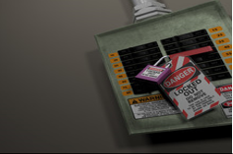Lockout/Tagout (LOTO) is a set of procedures that are used to ensure that equipment or systems are shut down, inoperable, and (where relevant) de-energized prior to any maintenance or repair work. It is a protection system against unintentional exposure to hazardous energy so that work can be performed safely.



Energy sources including electrical, mechanical, hydraulic, pneumatic, chemical, thermal, or other sources in machines and equipment can be hazardous to workers. During the servicing and maintenance of machines and equipment, the unexpected startup or release of stored energy can result in serious injury or death to workers.
NO! Only Authorized Employees can shut down and lock out equipment powered by hazardous energy.
Authorized Employees have been designated to lock out or tag out machines and equipment in order to perform servicing or maintenance. They must be trained in the purpose and use of LOTO procedures, the recognition of hazardous energy sources, the types and magnitude of hazardous energy sources expected to be encountered, and the methods that are necessary for proper energy isolation and control.
To meet compliance with the OSHA 1910.147 Control of Hazardous Energy (lockout/tagout) standard, University personnel that service or repair equipment that has any source of hazardous energy, must attend LOTO training. This training must be completed before working on such equipment or performing LOTO procedures.
Training will be provided if your responsibilities require you to perform LOTO. Contact EHS with any questions.
An Affected Person is any faculty, staff, or student whose responsibilities require them to operate or use a machine or equipment on which servicing or maintenance is being performed under lockout or tagout, or is required to be in an area in which such servicing or maintenance is being performed. They must be able to recognize lockout devices and tags and understand that the only person that can remove the tags and restore the energy source is the Authorized Person that took the machine or equipment out of service.
An Authorized Person has been designated and trained in LOTO procedures. They understand how to recognize hazardous energy sources and how to properly control and isolate that energy.
Authorized Persons will be trained in the purpose and use of LOTO procedures, the recognition of hazardous energy sources, the types and magnitude of hazardous energy sources expected to be encountered, and the methods that are necessary for proper energy isolation and control. They have responsibility to:
A LOTO device uses a positive means such as a lock to hold an energy isolation device in a safe position and prevent the startup of a machine or equipment. The placement of a tagout device on an energy isolating device to indicate that the energy isolating device and the equipment being controlled may not be operated until the tagout device is removed.

NOTE: Only the Authorized Person that performed LOTO can remove the devices and energize the equipment.
Call the Service Desk (Academic 434-924-2267 or Health System 434-924-3053)
NOTE: Anyone can perform service or maintenance on a piece of equipment if the only energy source that powers the equipment is a cord and plug. Once the plug is removed from the energy source it must be kept under that persons exclusive control until the task is complete.
Contact EHS at 434.982.4911 for any questions or guidance.